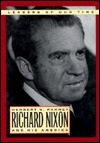Tags
American history, biographies, book reviews, Herbert Parmet, presidential biographies, Richard Nixon, US Presidents
 Herbert Parmet’s “Richard Nixon and His America” was published in 1990 – four years before Nixon’s death – and is one of the earliest serious studies of Nixon. Parmet authored eight presidential biographies and was a Distinguished Professor Emeritus of History at the City University of New York. His most recent book “Richard M. Nixon: An American Enigma” was published in 2007. Parmet died in 2017 at the age of 87.
Herbert Parmet’s “Richard Nixon and His America” was published in 1990 – four years before Nixon’s death – and is one of the earliest serious studies of Nixon. Parmet authored eight presidential biographies and was a Distinguished Professor Emeritus of History at the City University of New York. His most recent book “Richard M. Nixon: An American Enigma” was published in 2007. Parmet died in 2017 at the age of 87.
Never intended to serve as a conventional biography, this book is focused on Nixon’s political ascent (but not his fall) and on the attributes which made him a commanding American political figure. Six years of research, interviews with Nixon himself and access to many of his private papers underpin this 650-page book which, for all its detailed coverage, leaves significant parts of Nixon’s life unobserved.
The book begins during President Nixon’s early-morning visit with student protesters at the Lincoln Memorial in 1970 before stepping back a century or more in a manner reminiscent of a history text rather than a presidential biography. The narrative eventually jumps ahead several decades to briefly review some, but not most, of the important elements of Nixon’s childhood. Subsequent chapters generally proceed chronologically through the end of his presidency, but often in an extremely non-linear fashion.
Parmet’s willingness to bounce liberally along the timeline is the rule throughout this book, not the exception. Serious students of Nixon and his era may have little difficulty following along, but most readers will grow frustrated at the interminable back-and-forth nature of the narrative’s focus (which proceeds in neither a chronological nor topical fashion).
Unfortunately, the author’s writing style itself fails to ease the reader’s burden. When there is an opportunity to articulate an event in a clear and comprehensible manner Parmet almost always chooses (intentionally or otherwise) to describe it in a way that obfuscates, rather than clarifies, history. And I would wager that the word “engaging” has never been used to describe this book.
Many topics are essentially uncovered including any meaningful connection of Nixon’s childhood to his adult character and personality, his “Checkers” speech, the Nixon-Kennedy debates, his domestic legislative priorities as president, Watergate and his post-presidency.
But for all its shortcomings what “Richard Nixon and His America” does offer most readers familiar with Nixon’s life is a collection of insightful one-liners, observations and analyses focused on various facets of Nixon’s life as well as American political history more generally. While these may seem few and far between during the course of this book, by the end there were several dozen quips I deemed unusually successful.
An early chapter on Nixon’s service as Eisenhower’s vice president is comparatively interesting (though, characteristically, it is not particularly straightforward) and Parmet’s comparison of Nixon to JFK is intriguing. Valuable insights are offered into Dwight Eisenhower, Nelson Rockefeller and Howard Hughes, among others. And Parmet provides a useful analysis of the electoral “inconsistencies” associated with Nixon’s presidential loss to JFK in 1960.
Overall, however, Herbert Parmet’s “Richard Nixon and His America” is likely to appeal only to a relatively narrow universe of readers. From a distance it appears to be a dated but thorough introduction to Richard Nixon, but in reality it is a wandering but penetrating Schlesinger-style political treatise which will selectively fascinate only the most serious students of Nixon and his era.
Overall rating: 2½ stars

Reblogged this on Practically Historical.